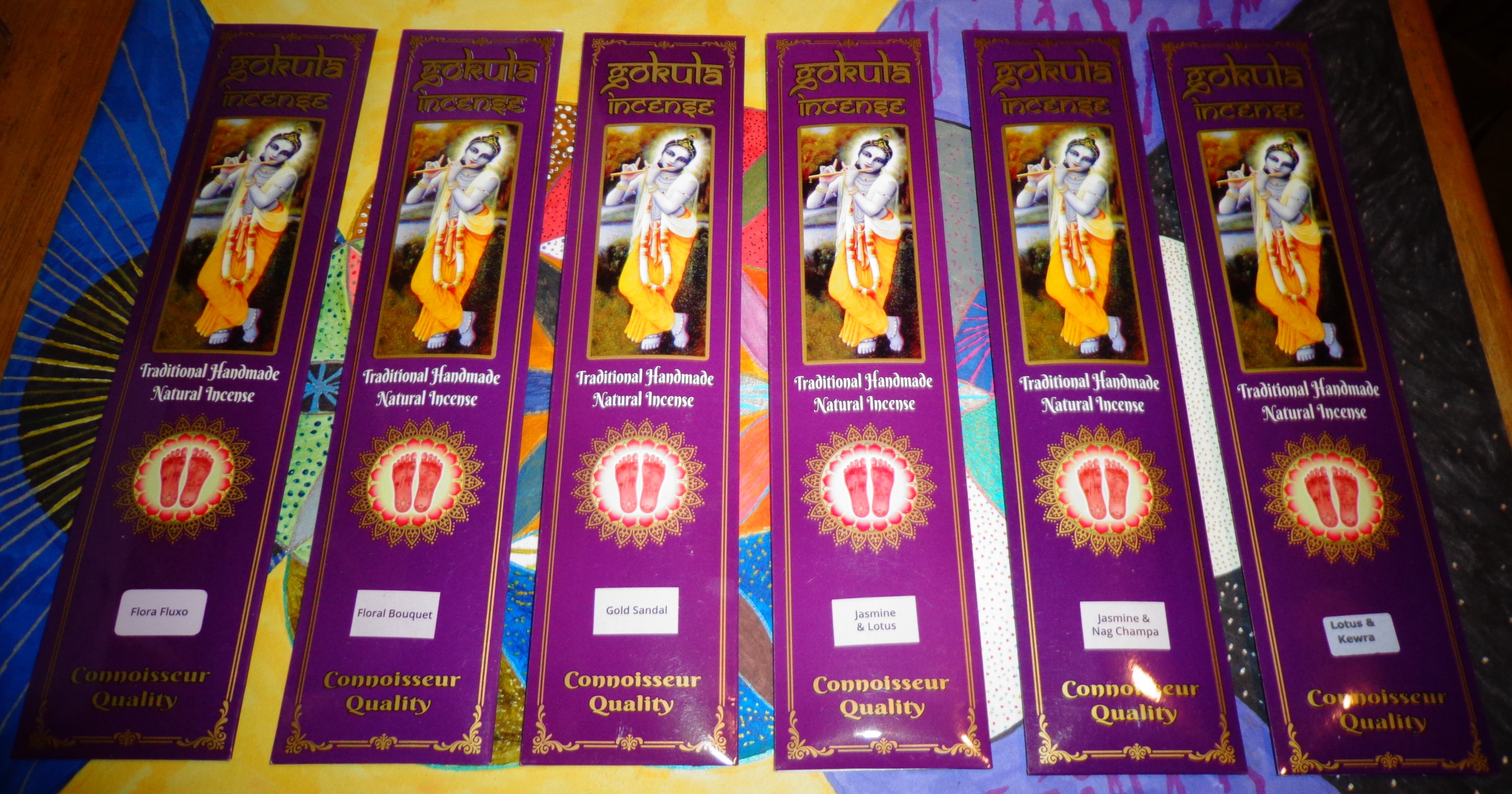 This is the second of four in a series of Gokula Incense reviews, please see the first installment for an introduction to the company.
This is the second of four in a series of Gokula Incense reviews, please see the first installment for an introduction to the company.
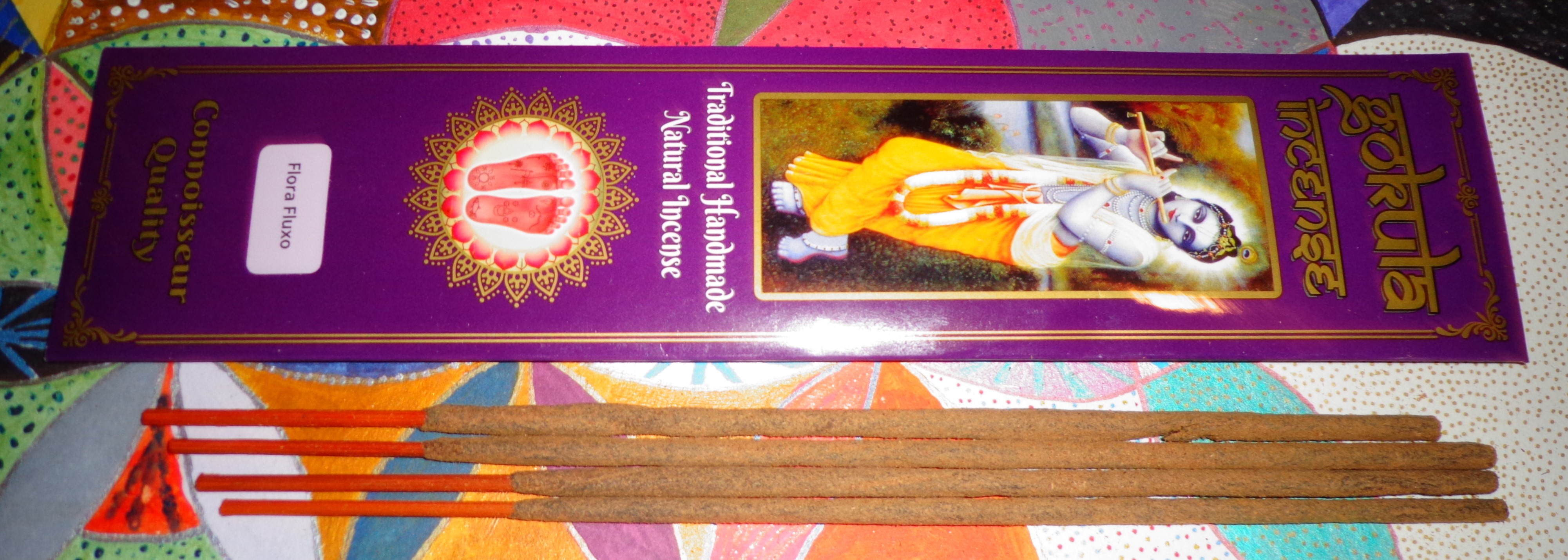 My general impression of flora/fluxo incenses is they usually come with an orange dipped stick (either full or just the end). And Gokula’s variant (one of them really) is actually called Flora Fluxo. I have reviewed or burned so many of these types of incenses in the last couple months that they probably feel more redundant to me than they actually are, but if you’re not familiar with the style then usually the standard version (kind of like how blue box Nag Champa is – or maybe used to be – the standard for those incenses) is the red package Sai Flora and it’s a reasonable baseline although it is heavily perfumed and often stronger than those I have reviewed lately. Gokula’s version is somewhat muted and not quite as bright and brassy as Sai Flora. Most floras and fluxos have earthier levels in them but they’re usually much more buried than they are here, which tends to give me an August, almost Dionysian vibe like prunes or grapes. I am not sure the balance maybe quite works for me on this stick, but I would not take that as gospel because most are just minor tweaks from one to the other and if you like the style, you’re likely going to search for the one that works for you. This is certainly a reasonable quality take.
My general impression of flora/fluxo incenses is they usually come with an orange dipped stick (either full or just the end). And Gokula’s variant (one of them really) is actually called Flora Fluxo. I have reviewed or burned so many of these types of incenses in the last couple months that they probably feel more redundant to me than they actually are, but if you’re not familiar with the style then usually the standard version (kind of like how blue box Nag Champa is – or maybe used to be – the standard for those incenses) is the red package Sai Flora and it’s a reasonable baseline although it is heavily perfumed and often stronger than those I have reviewed lately. Gokula’s version is somewhat muted and not quite as bright and brassy as Sai Flora. Most floras and fluxos have earthier levels in them but they’re usually much more buried than they are here, which tends to give me an August, almost Dionysian vibe like prunes or grapes. I am not sure the balance maybe quite works for me on this stick, but I would not take that as gospel because most are just minor tweaks from one to the other and if you like the style, you’re likely going to search for the one that works for you. This is certainly a reasonable quality take.
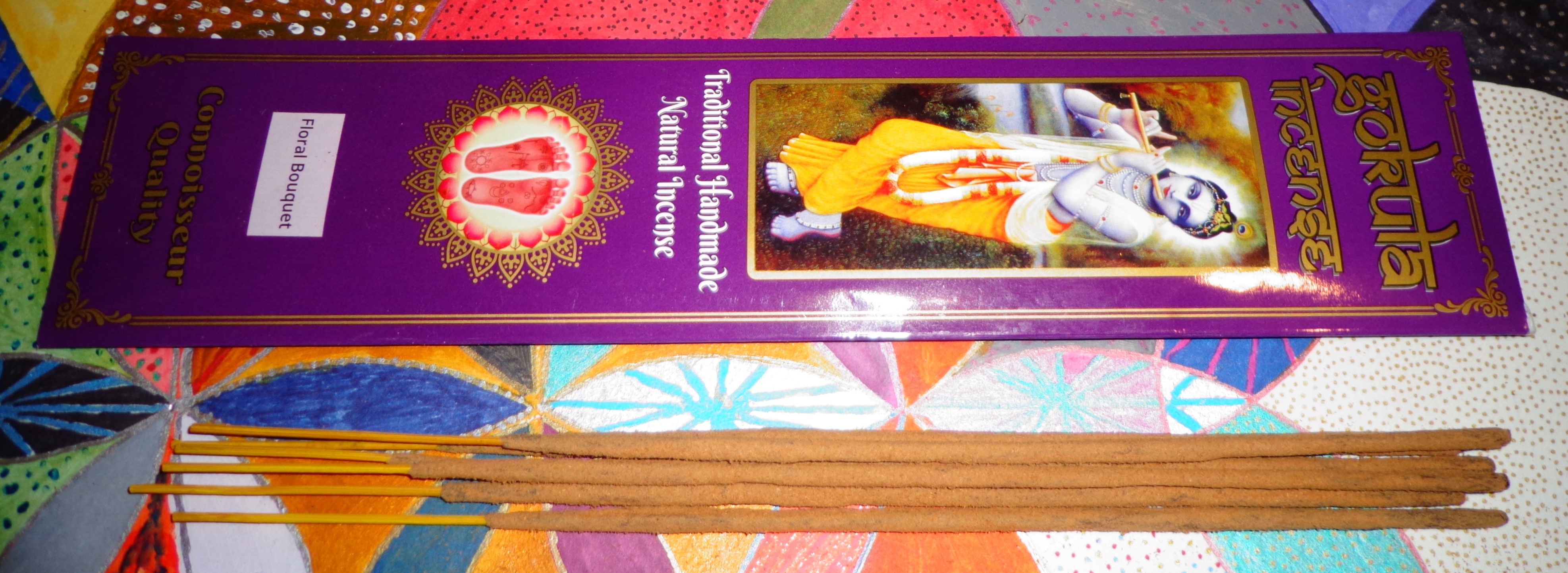 Floral Bouquet actually does what it says it’s going to do and presents a floral mix that’s very pink and sweet. It’s a bit of a masala although still fairly firm but it’s worth noting because it doesn’t feel like it’s battling charcoal but is more of a blend with a bit of woodiness. I’ve gone on record many times the pitfalls of presenting general florals, but this one has no bitterness or off notes and it’s probably friendly enough to be kind even to incense muggles. It actually reminds me a little of some of the old Dhuni incenses, perhaps in a more manageable form than that, but approaching that kind of pleasantness (I keep being reminded by the sadly lamented Dhuni Frangipani for some reason). It feels like it has something like pink Valentine’s candy at heart, but the structure of it seems to balance it out in a good way.
Floral Bouquet actually does what it says it’s going to do and presents a floral mix that’s very pink and sweet. It’s a bit of a masala although still fairly firm but it’s worth noting because it doesn’t feel like it’s battling charcoal but is more of a blend with a bit of woodiness. I’ve gone on record many times the pitfalls of presenting general florals, but this one has no bitterness or off notes and it’s probably friendly enough to be kind even to incense muggles. It actually reminds me a little of some of the old Dhuni incenses, perhaps in a more manageable form than that, but approaching that kind of pleasantness (I keep being reminded by the sadly lamented Dhuni Frangipani for some reason). It feels like it has something like pink Valentine’s candy at heart, but the structure of it seems to balance it out in a good way.
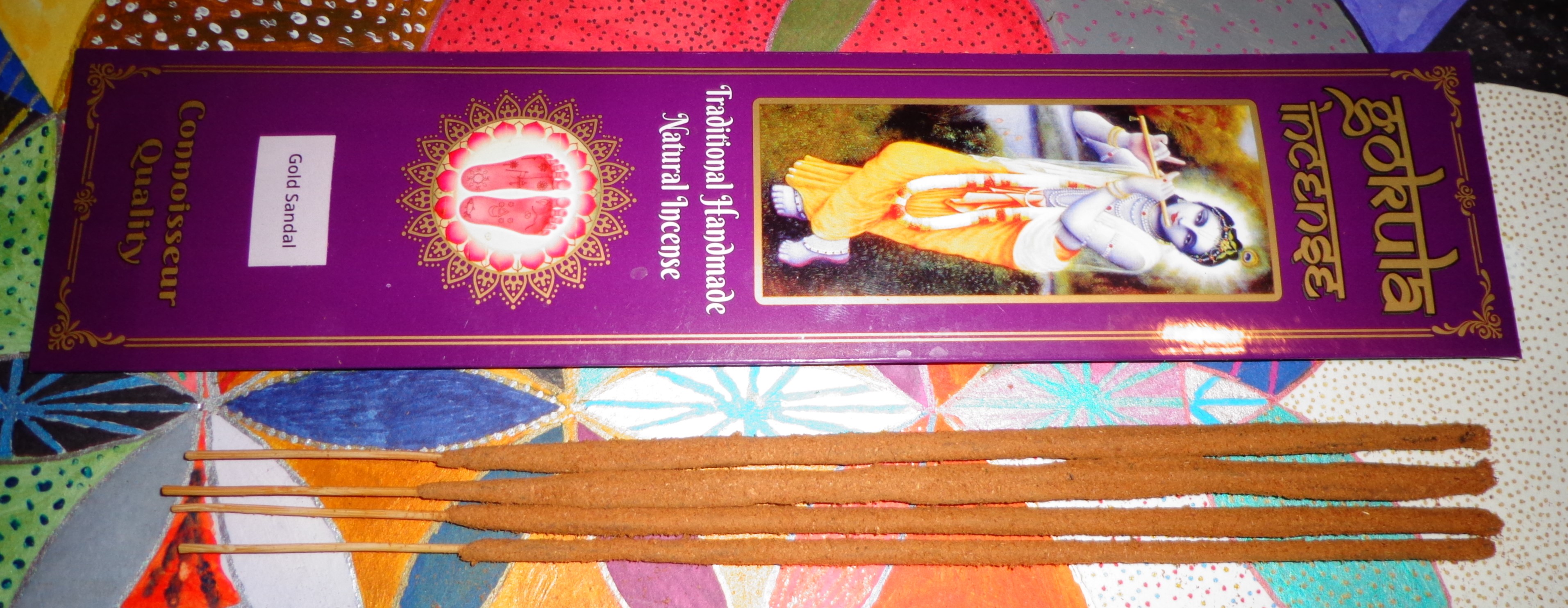 Gold Sandal seems to be a cousin to the Agar Sandal we reviewed last time, but like a lot of midline Indian sandalwood incenses, they really don’t smell a lot like sandalwood. There is some inherent woodiness to the incense but there are bitter/sour off notes as well as some really strangely placed fruity notes like peach or apricot in the middle. One wonders if this was an attempt to build a sandalwood out of a different set of ingredients. The Agar Sandal actually felt a bit closer to me in getting to that note or at least it ended up being more genuinely woody than this one. Certainly, the overall bouquet of the Agar Sandal is much more coherent, so I’d suggested starting there before heading to this one.
Gold Sandal seems to be a cousin to the Agar Sandal we reviewed last time, but like a lot of midline Indian sandalwood incenses, they really don’t smell a lot like sandalwood. There is some inherent woodiness to the incense but there are bitter/sour off notes as well as some really strangely placed fruity notes like peach or apricot in the middle. One wonders if this was an attempt to build a sandalwood out of a different set of ingredients. The Agar Sandal actually felt a bit closer to me in getting to that note or at least it ended up being more genuinely woody than this one. Certainly, the overall bouquet of the Agar Sandal is much more coherent, so I’d suggested starting there before heading to this one.
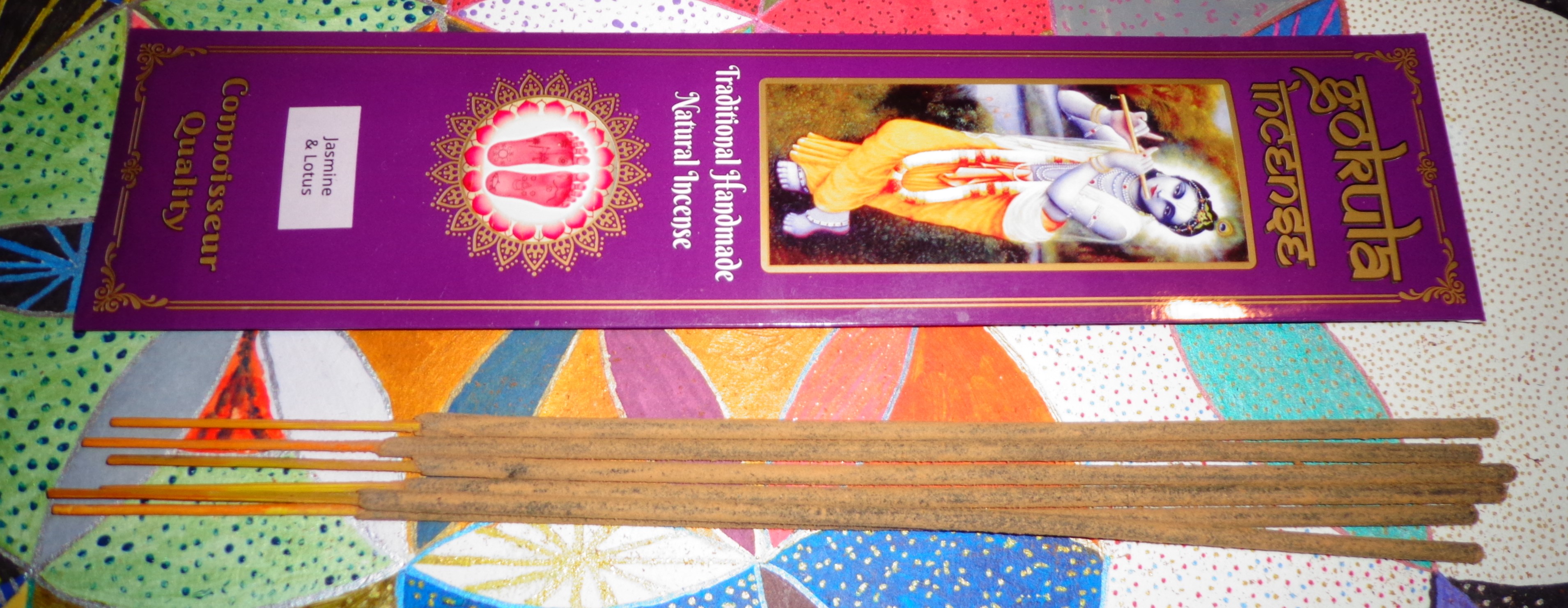 Even though I am going in alphabetical order, the next three incenses share quite a few of the same ingredients and operate very closely in style. The Jasmine and Lotus (and according to the description juhi, kewra and parijata) is an interesting blend for sure in that you’d expect that to be tilted way over into jasmine when the noticeable lead aroma seems to be something similar to the blue lotus that’s part of the Madhavadas catalog. It’s a very pretty, powdery sort of scent where if you can imagine it, the jasmine kind of faintly provides a background color to give a bit of complexity to the lotus scent. And honestly I think that is where jasmine is at its best. So after introducing some incenses Gokula imports that may be wobbly, this is one that I think has a rather distinct sort of mix I haven’t turned up in other catalogs and that is indeed what one often looks for in an incense.
Even though I am going in alphabetical order, the next three incenses share quite a few of the same ingredients and operate very closely in style. The Jasmine and Lotus (and according to the description juhi, kewra and parijata) is an interesting blend for sure in that you’d expect that to be tilted way over into jasmine when the noticeable lead aroma seems to be something similar to the blue lotus that’s part of the Madhavadas catalog. It’s a very pretty, powdery sort of scent where if you can imagine it, the jasmine kind of faintly provides a background color to give a bit of complexity to the lotus scent. And honestly I think that is where jasmine is at its best. So after introducing some incenses Gokula imports that may be wobbly, this is one that I think has a rather distinct sort of mix I haven’t turned up in other catalogs and that is indeed what one often looks for in an incense.
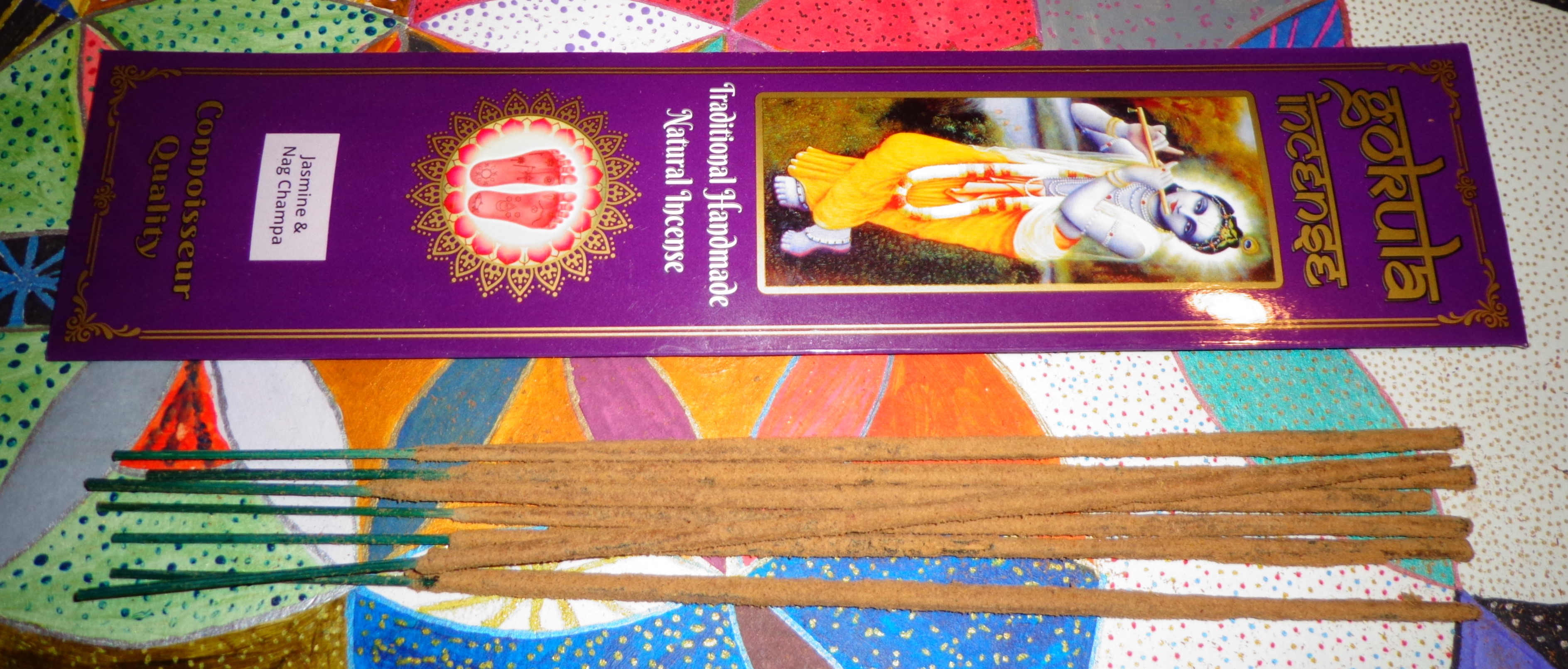 And better yet, the Jasmine & Nag Champa may be one of Gokula’s best. While I’m not sure either aroma is dead on, they are both close and the juhi and lotus they meld with work well together. Whatever one has in mind for a mix like this, it’s going to be a bit different than you expect. While the champa perfume isn’t the classic style you get on something like the AB or TOI Gold Nagchampa, it does have a much more powdery bottom to it that evinces maybe a bit of halmaddi in the masala. The top note is very pretty and while you can kind of sense jasmine in there somewhere it’s not unlike the previous incense where it seems to mostly come out in some aspects of the bouquet as part of a merger. And overall, it leans over into pink florals a bit.
And better yet, the Jasmine & Nag Champa may be one of Gokula’s best. While I’m not sure either aroma is dead on, they are both close and the juhi and lotus they meld with work well together. Whatever one has in mind for a mix like this, it’s going to be a bit different than you expect. While the champa perfume isn’t the classic style you get on something like the AB or TOI Gold Nagchampa, it does have a much more powdery bottom to it that evinces maybe a bit of halmaddi in the masala. The top note is very pretty and while you can kind of sense jasmine in there somewhere it’s not unlike the previous incense where it seems to mostly come out in some aspects of the bouquet as part of a merger. And overall, it leans over into pink florals a bit.
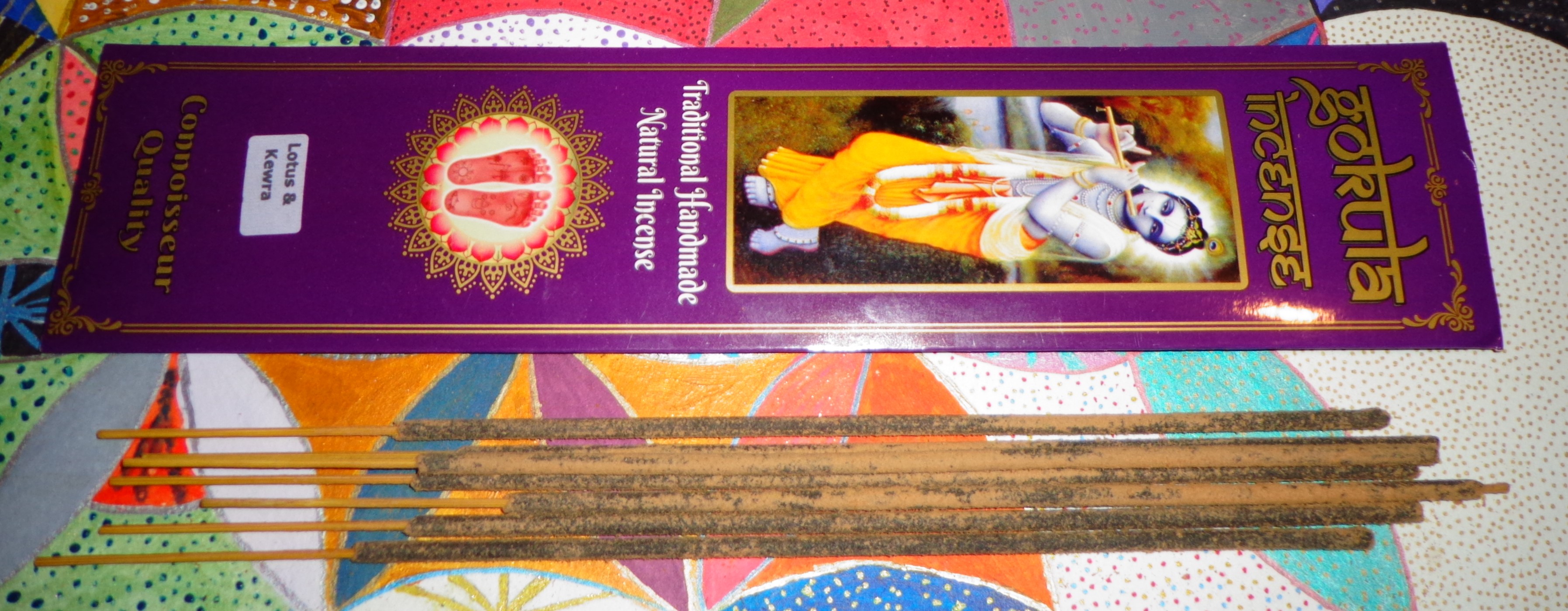 Finally the Lotus & Kewra is a very interesting experiment. This stick is a lightly dusted charcoal, but even moving back from a more masala like approach this still seems to have the same sort of warm and gentle powdery qualities of the last two incenses, which I like very much. The charcoal does spike a little through it as is always the case with floral charcoals but the perfume mix is quite nice nonetheless with what seems like either a balsamic or vanilla like quality in the middle. And yes there is even a distinct kewra note through the middle! Screwpine is definitely an aroma I’d like to see more often as it’s such a distinct and different scent to anything else. While the lotus isn’t quite as distinct as it is in the incense above where it’s paired with jasmine, and this may be because of the kewra, the resulting merge is certainly worth it. The incense description also describes the blend “in a sandalwood base with swirling notes of champa and marigold.” The powdery quality is certainly champa-esque and the marigold can be faintly ascertained but to my nose I don’t get any sandalwood and nor would I think you’d need to. Whatever the case this is definitely a Gokula winner.
Finally the Lotus & Kewra is a very interesting experiment. This stick is a lightly dusted charcoal, but even moving back from a more masala like approach this still seems to have the same sort of warm and gentle powdery qualities of the last two incenses, which I like very much. The charcoal does spike a little through it as is always the case with floral charcoals but the perfume mix is quite nice nonetheless with what seems like either a balsamic or vanilla like quality in the middle. And yes there is even a distinct kewra note through the middle! Screwpine is definitely an aroma I’d like to see more often as it’s such a distinct and different scent to anything else. While the lotus isn’t quite as distinct as it is in the incense above where it’s paired with jasmine, and this may be because of the kewra, the resulting merge is certainly worth it. The incense description also describes the blend “in a sandalwood base with swirling notes of champa and marigold.” The powdery quality is certainly champa-esque and the marigold can be faintly ascertained but to my nose I don’t get any sandalwood and nor would I think you’d need to. Whatever the case this is definitely a Gokula winner.





 This next quartet from the Temple of Incense line shows some interesting variations. As you explore the line, you find a really wide range of different scents that leads one to expect that there’s nearly something for everyone in the group. This group contains basically two (somewhat similar) charcoals and two very sweet and almost confectionary-like incenses. It has been truly fun to go through this range, there’s a surprise at every bend.
This next quartet from the Temple of Incense line shows some interesting variations. As you explore the line, you find a really wide range of different scents that leads one to expect that there’s nearly something for everyone in the group. This group contains basically two (somewhat similar) charcoals and two very sweet and almost confectionary-like incenses. It has been truly fun to go through this range, there’s a surprise at every bend.
 I was working through some Ramakrishnanda incenses recently and noticed that the company had changed their Govardhana incense away from the original loban and coconut aroma to wood rose and vanilla. As someone who felt that the stick was one of the most successful coconut scented incenses I had tried, I was disappointed to see it go, so perhaps it’s fortuitous to try a new coconut incense with
I was working through some Ramakrishnanda incenses recently and noticed that the company had changed their Govardhana incense away from the original loban and coconut aroma to wood rose and vanilla. As someone who felt that the stick was one of the most successful coconut scented incenses I had tried, I was disappointed to see it go, so perhaps it’s fortuitous to try a new coconut incense with 

You must be logged in to post a comment.